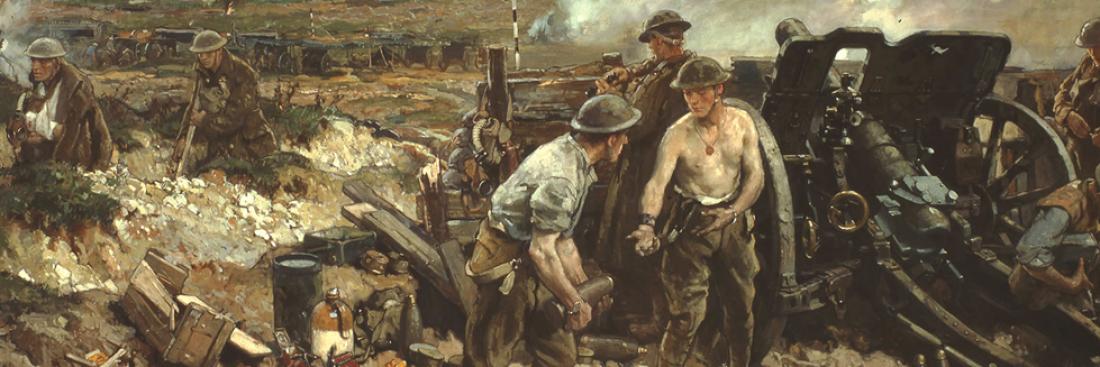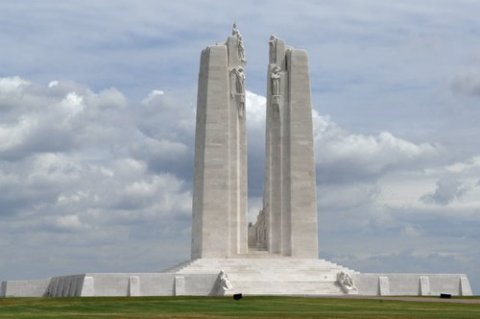The Canadians and the Great War

La Bataille de Vimy. peinture de Richard Jack. Source : Musée canadien de la guerre
In 1914, Canada, along with Australia and New Zealand, was not a colony. It was a powerful dominion, an autonomous state, attached to the home country by mutual agreement. The dominions were not obliged to provide the motherland with either subsidies or military contingents.
Corps 1
However, in August 1914, Robert Borden's government entered the country in the war. Without opposition, the parliament adopted the War Measures Act, a declaration by which the parliament agreed to suspend civil liberties and regulate areas sensitive to the correct running of the war and the mobilisation of an expeditionary corps.
In military terms, Canada was not ready to enter the war. Its army was made up of scarcely 3,100 men, underequipped and poorly trained, even if it could also call up 60,000 volunteers in the militia.
The volunteers came forward. More anglophones than francophones responded, the French-speaking community's military traditions being weaker and its links to the old continent being, at that time, more strained. In the space of a few weeks, over 32,000 men were assembled at the camp in Valcartier, near Quebec. On 3 October 1914, Canada's first expeditionary corps embarked for England. Furthermore, six million soldiers in the future Canadian confederation province of Newfoundland (1949), a British colony at the time, served in the Newfoundland Regiment, which achieved glory on the Western Front.
Corps 2
In February 1915, the 1st Canadian Division took its position along the Belgian front line and in the north of France.
In April, the division was sent to Ypres. It was during this battle that the Canadians lost over 6,000 men, in part due to the toxic gases used by the Germans for the first time. Despite these harsh conditions, the Canadians stood their ground and forged a reputation as formidable soldiers. After the Battle of Ypres, the Canadians marched south to join the allied offensives in Givenchy and Festubert. While the Canadians suffered heavy losses, they achieved their war objectives.
In 1915 and then in 1916, three newly-formed Canadian divisions left for France. At this time, the Canadians asked for a Canadian Corps to be created, grouping together all of their armed forces, to be placed under the command of Lieutenant General Alderson. Major General Currie took command of the 1st Division and Major General Turner the 2nd Division. In December 1915, the 3rd Canadian Division was formed and placed under the command of Major General Mercer.
From June to November 1916, in Beaumont-Hamel, during the Battle of the Somme, the carnage was brutal and the men serving in the Newfoundland Regiment were almost totally annihilated: on 1 July alone, only 68 of the 800 soldiers in the regiment walked away unharmed. In late August, the Canadian Divisions took part in the assault on Courcelette. One part of their attack was the longest trench built by the Germans on the Western Front, the Regina Trench. Out of all the Canadian troops, nearly 25,000 men were incapacitated between July and November 1916. In April, 1917, despite the grave losses suffered in Verdun and on the Somme, General Nivelle, flouted the apparent weariness of the soldiers and decided to launch 50 divisions in a large-scale offensive between Soissons and Reims along the Chemin des Dames. The British troops were to create a diversion attack in the region of Arras.
The Canadians' mission was to take Vimy Ridge, a six-kilometre crest, overlooking the Flanders Plain from 150 metres high, solidly held by the Germans since late 1914.
Vimy Ridge was key to the German defence system, protecting the strategic junction along the main part of the Hindenburg line and the German defence systems scattered towards the north. The mission was prepared, rehearsed and planned like no other. On 20 March 1917, the preparatory bombardment began. The actual attack was launched on Easter Monday, 9 April 1917. The four divisions, reunited for the first time in combat had taken control of the crest by the middle of the afternoon; two further German positions were taken three days later.

General view of the monument, available in large format in the resources area. Source: (photo) Jean-Pierre Le Padellec
Some 10,600 Canadian soldiers fell and over 3,600 killed, but the Germans were forced to withdraw more than 10 kilometres, leaving 4,000 men in the hands of the Allies. The success of this operation was due to rational planning and meticulous preparation, but also the valliance and sense of duty shown by the Canadian troops.
Today, the Battle of Vimy is commemorated in Canada on the same day as the Armistice of 11 November. In1988, the Prime Minister Brian Mulroney repeated the idea held by some that modern Canada was born from the trenches in Vimy. Soldiers from Montreal and from Ottawa fought together as Canadians and not just as subjects of his Majesty George V. It was in Vimy, in fact, that the Canadians were able to step out from under Britain's shadow. These soldiers were no longer considered colonial. Many believe 9 April 1917 was the day that sealed the union of Canadian citizens through the sacrifice of its troops.
During the course of the following summer, the Canadian Corps received its first Canadian commander: Arthur Currie. Faced with the increasing number of losses, on 24 July 1917, the Prime Minister introduced a conscription bill: all unmarried or widowed men without children and between the ages of 20 and 35 were enlisted. In Quebec, this measure caused riots. Nearly 50% of the Quebecan contingents refused to join. Not long after, the Canadian troops fought in the Battle of Passchendaele, which cost them many lives (15,650 men) and the Battle of Lens (nearly 10,000 men) in August and in November 1917.
The Battle of Cambrai was won by the British with the first true attack using tanks. The Canadian cavalry brigade and the Newfoundland Regiment won fame for their part in the attack. Consequently, the Newfoudland Regiment was granted the title ”royal”, a unique honour during the First World War. In spring 1918, the Germans mounted their last major offensive, but the Allies resisted and turned the situation to their advantage.
In tribute to the front-line role played by the Canadian Corps in the Allied advance, the period from 4 August to 11 November 1918 was named Canada's Hundred Days. On 8 August, the Canadians led an attack in Amiens. The attack was not preceded by any preliminary bombardments and the Canadians arrived in secret, totally surprising the enemy. Flanked by the Australians and the French, and preceded by tanks, the Canadian Corps advanced several kilometres in three days. For Ludendorff, this was the ”day of mourning” for the Germany army.
After the breakthrough at Amiens, the Canadians were transferred to Arras to attack the Hindenburg line, the German's key defence system. The Canadian troops won their battle on 2 September and liberated Arras. The 22nd Quebecan Battalion took Chérisy, where it lost all its officers and by the evening of the day of the battle, had only 39 men standing. Next, the Canadian Corps liberated Valenciennes, took Mount Houy and entered Mons on the day of the Armistice. Some 619,639 men and women (450,000 in France and Belgium) served in the Canadian forces between 1914 and 1918. More than 65,000 died.
external websites :
monuments aux mort :
62_Vimy_Mémorial
62_Vimy

